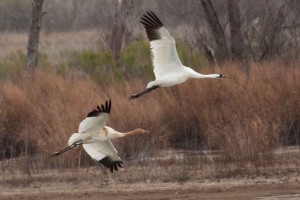by Whooping Crane Conservation Association based on Aransas NWR report
Aerial surveys of the whooping crane population wintering on the Aransas National Wildlife Refuge were performed by U.S. Fish and Wildlife Service biologists last week. Refuge biologists have just completed their analysis of the census data and made their findings available. Three aerial surveys were conducted. A survey on January 26th was cut short due to high winds. Surveys conducted on January 27th and 29th were approximately 4 1/2 hours and each systematically searched Matagorda Island, San Jose Island, Blackjack Peninsula, Lamar Peninsula, Dewberry Island, and Welder Flats. Conditions for surveying were most favorable on January 29th, when observers detected 193 whooping cranes. Of the 193 cranes, 125 were white plumage birds, 23 were juvenile birds, and 3 were undistinguished.
The numbers do not represent a complete “census” of birds in the surveyed area, but will provide biologists a means to estimate the whooping crane population size. It is possible that some of the whoopers on the refuge were not detected by the observers. Analysis of these data is ongoing.
At least 16 additional Aransas-Wood Buffalo population of whooping cranes are currently residing outside of the typical wintering area, as far away as Nebraska. Based on the available data, 209 whoopers have been accounted for. The next survey flight will be scheduled for mid-February.
Approximately 5% of whooping cranes detected on the 27th and 29th were found using man-made freshwater sources, such as stock ponds and windmills. Cranes were using both upland and marsh communities. They are naturally supplementing their own food sources by wintering around freshwater lakes.
Refuge personnel continue to help alleviate the low food resources by adding to the prescribed burn totals. This winter the refuge has burned 8,095 acres of habitat that have recorded whooping crane usage. Biologists observed the whooping cranes eating roasted acorns and are seeing continued use. There are still an additional 6,129 acres planned to be burn for the remaining whooping crane season.
Many people have inquired whether the refuge plans to implement a supplemental feeding program for whooping cranes this winter. At this time, refuge officials are concerned about the negative impacts of supplemental feeding. Previous efforts to supplemental feed were not considered successful as only a small portion of the birds actually fed on the shelled corn.
Whooping cranes are territorial and do not naturally gather together to feed. Encouraging them to do so changes their natural behavior; it also creates greater opportunities to transmit diseases, parasites, and makes them more vulnerable to predators. Furthermore, when left out in warm and moist environments, like coastal marsh areas, corn can grow Aspergillis molds. Aflatoxins, which are produced by the molds, can be lethal to whooping cranes and other wildlife. Where whooping cranes may be present, landowners should be aware of the risks that aflatoxins pose. If corn is being be used for feeding other wildlife in areas where whooping cranes may be present, U.S. Fish and Wildlife Service scientists highly recommend purchasing aflatoxin-free corn.
Aransas National Wildlife Refuge has received 0.84 inches of precipitation for the month of January. Central Texas has been fortunate to receive some much needed rainfall recently and the water has raised the Guadalupe River to above flood stage levels from Jan 28th- Jan 31st. This river flows into the San Antonio Bay and the flush of freshwater is expected to further decrease salinity levels. Currently, salinity levels are reported to be 23.2 parts per thousand (ppt) compared to 35.3ppt on December 14, 2011.
January 24th data from Texas Parks and Wildlife Department indicates that samples taken in the San Antonio, East Matagorda, and Espiritu bays were free of red tide. It
is still persisting in some of the surrounding bays but in very low concentrations.
Aransas Refuge officials reported that a second radioed whooping crane chick has died this winter since their last report. The carcass has been sent off for testing and we are awaiting results.


